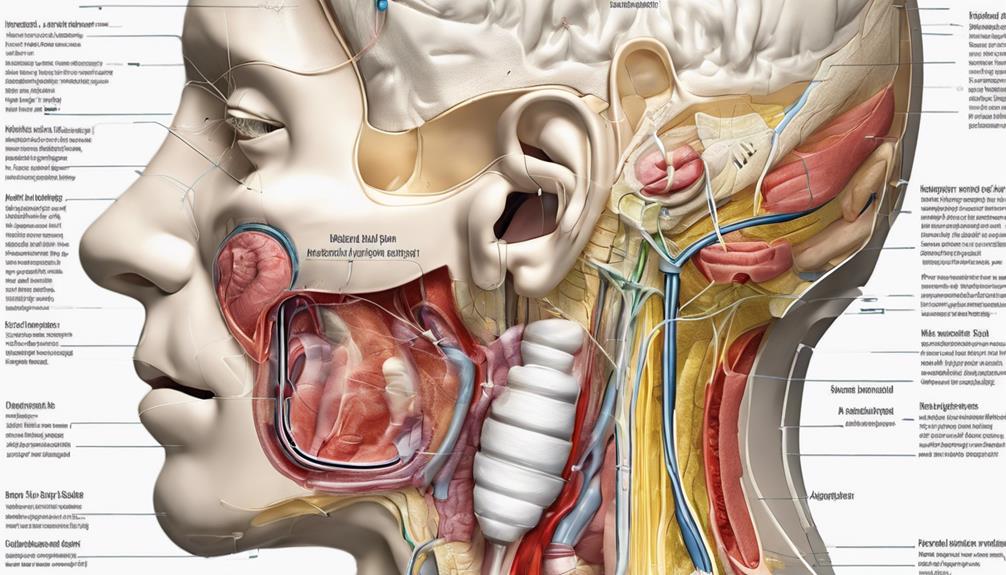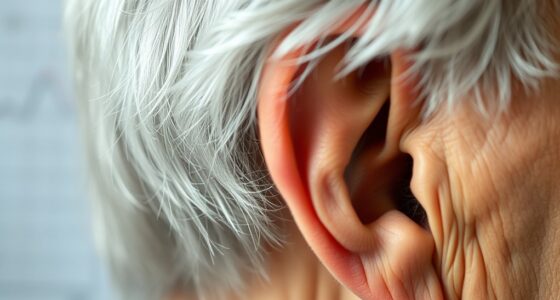As a team, we discovered a surprising fact: approximately 60% of individuals with hearing impairments experience uneven hearing loss.
While this statistic may raise eyebrows, our guide aims to unravel the complexities behind this prevalent issue. By shedding light on various causes and their implications, we lay the groundwork for a deeper understanding of this unique auditory challenge.
Stay tuned to uncover the intricate web of factors contributing to asymmetrical hearing loss and how this guide can offer clarity and guidance in navigating this lesser-known aspect of hearing health.
Key Takeaways
- Meniere's disease and vestibular schwannoma are common causes of asymmetrical hearing loss.
- Genetic factors, aging, head trauma, and loud noises can contribute to varying degrees of hearing loss.
- Ototoxic medications like antibiotics and chemotherapy drugs can damage the auditory system.
- Timely diagnosis, monitoring, and tailored interventions are crucial for managing asymmetric hearing loss effectively.
Understanding Asymmetrical Hearing Loss Causes
When examining the complexities of asymmetrical hearing loss causes, it becomes evident that a range of factors play significant roles in its development. These include Meniere's disease, characterized by inner ear fluid accumulation, which can lead to fluctuating hearing loss. Additionally, vestibular schwannoma, a noncancerous tumor on the main nerve leading from the inner ear to the brain, can also cause asymmetrical hearing loss.
Genetic factors and aging contribute to the gradual deterioration of hearing, often affecting one ear more than the other. Head trauma, exposure to ototoxic medications, loud noises, and infections can damage the auditory system asymmetrically. Understanding these diverse causes is crucial for accurate diagnosis and appropriate management of asymmetrical hearing loss.
Comprehensive medical evaluations are essential to pinpoint the specific underlying factors contributing to this condition.
Common Triggers of Asymmetrical Hearing Loss

Exposure to loud noise, genetic factors, head injuries, ototoxic medications, and tumors are common triggers of asymmetrical hearing loss.
Noise exposure, such as from machinery or concerts, can cause damage to the delicate hair cells in the inner ear, leading to asymmetrical sensorineural hearing loss.
Genetic factors play a significant role, with certain inherited conditions or family history contributing to the development of uneven hearing loss.
Traumatic head injuries, like skull fractures or concussions, can result in varying degrees of hearing loss in each ear, further exacerbating the asymmetry.
Ototoxic medications, including specific antibiotics and chemotherapy drugs, have the potential to induce asymmetrical hearing loss as a side effect by damaging the auditory system.
Additionally, the growth of tumors, such as acoustic neuromas, can affect hearing differently in each ear, leading to asymmetrical hearing loss. Understanding these common triggers is crucial in diagnosing and managing age-related hearing loss effectively.
Genetic Factors in Asymmetrical Hearing Loss
Genetic factors significantly influence the susceptibility and severity of asymmetrical hearing loss, playing a crucial role in the manifestation of varying hearing loss patterns within families. Specific gene mutations have been identified as contributors to the development of asymmetrical hearing loss. Syndromic genetic disorders such as Waardenburg syndrome and Pendred syndrome are known to be associated with asymmetrical hearing loss presentations. Variations in the GJB2 gene have been linked to both bilateral and asymmetrical sensorineural hearing loss, highlighting the complex genetic underpinnings of this condition.
Understanding the genetic basis of asymmetrical hearing loss is essential as it can lead to more personalized treatment approaches. By identifying specific genetic factors, healthcare professionals can tailor interventions to address individual needs effectively. This targeted approach can improve outcomes and enhance the quality of life for individuals with asymmetrical hearing loss. Therefore, genetic evaluations play a crucial role in the management and treatment of this condition.
Ototoxic Medications and Hearing Asymmetry

Utilizing ototoxic medications poses a potential risk for inducing hearing asymmetry due to their damaging effects on the inner ear or auditory nerve. These medications can lead to various degrees of hearing loss or imbalance, ranging from temporary to permanent based on factors such as the specific drug and dosage. Monitoring for signs of hearing impairment while taking ototoxic medications is essential to mitigate the risk of long-term damage. Discussing potential hearing-related side effects with healthcare providers is crucial for patients undergoing treatment with ototoxic medications.
- Ototoxic medications are drugs that damage the inner ear or auditory nerve, potentially causing hearing loss or imbalance.
- Common ototoxic medications include certain antibiotics, chemotherapy drugs, and high doses of aspirin.
- The impact of ototoxic medications on hearing can vary from temporary to permanent, depending on the drug and dosage.
- Monitoring for signs of hearing loss while taking ototoxic medications is crucial to prevent long-term damage.
Health Conditions Linked to Hearing Asymmetry
Health conditions such as Meniere's disease, vestibular schwannoma, congenital stenosis, and shooters ear are all linked to asymmetrical hearing loss, presenting various symptoms and implications requiring specific medical attention.
Meniere's disease manifests with vertigo, tinnitus, and hearing loss, often affecting one ear more than the other.
Vestibular schwannoma, a noncancerous tumor on the vestibulocochlear nerve, can lead to asymmetrical hearing loss along with balance issues.
Congenital stenosis, characterized by a narrow ear canal present from birth, may contribute to hearing asymmetry.
Shooters ear, resulting from exposure to loud firearms, can cause hearing loss that differs between ears due to varying noise exposure levels.
Understanding these health conditions is crucial for identifying potential causes of asymmetrical hearing loss and guiding appropriate medical interventions. Timely diagnosis and management can help mitigate the impact of these conditions on hearing health and overall well-being.
Frequently Asked Questions
What Is the Most Common Cause of Asymmetrical Hearing Loss?
The most common cause of asymmetrical hearing loss is sensorineural hearing loss, impacting the inner ear or auditory nerve. Other contributing factors include aging, genetic predispositions, noise exposure, head injuries, medications that are ototoxic, tumors, infections, and conditions like Ménière's disease.
An evaluation by a healthcare professional is crucial to pinpointing the exact cause of asymmetrical hearing loss. In some instances, familial history may suggest a genetic link to this condition.
What Is the Criteria for Hearing Loss Asymmetry?
We define hearing loss asymmetry as a measurable difference of at least 15 decibels between the ears. This condition is diagnosed when one ear experiences significantly greater hearing loss than the other.
It's crucial to differentiate between asymmetrical hearing loss and unilateral hearing loss, which affects only one ear. Audiologists rely on specific thresholds and measurements to accurately assess and classify the severity of asymmetrical hearing loss.
What Is the Best Hearing Aid for Asymmetrical Hearing Loss?
When it comes to finding the best hearing aid for asymmetrical hearing loss, we need to consider the individual's unique hearing needs and the severity of the impairment in each ear. Binaural hearing aids are often recommended as they provide balanced sound amplification, enhancing overall auditory perception.
These aids can be customized to suit each ear's requirements, ensuring optimal sound quality and clarity. Cochlear implants might be considered for severe cases where traditional aids aren't sufficient.
What Causes Asymmetrical Ears?
Asymmetrical ears can result from various factors, including genetics, congenital conditions, trauma, infections, tumors, or neurological disorders. Structural abnormalities in the ear canal, middle ear, or inner ear can also lead to asymmetrical ears.
Conditions like microtia, anotia, or craniofacial abnormalities may be associated with this issue. To pinpoint the exact cause of asymmetrical ears, imaging studies, genetic testing, or a thorough medical history review may be necessary.
Conclusion
In conclusion, we've uncovered the intricate web of factors that contribute to asymmetrical hearing loss. From genetic predispositions to ototoxic medications, the journey to auditory balance is riddled with twists and turns.
But fear not, dear readers, for armed with knowledge and determination, we can navigate these challenges with grace and resilience. So, let's embrace our asymmetrical ears as unique badges of honor, for they remind us of the fascinating complexity of the human body.
Stay curious, stay informed, and let's conquer hearing asymmetry together.











